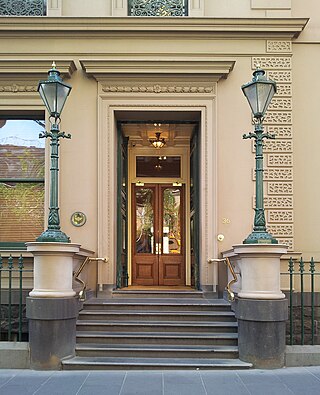Related Research Articles

The Melbourne Club is a private social club established in 1838 and located at 36 Collins Street, Melbourne.

The Royal Scottish Geographical Society (RSGS) is an educational charity based in Perth, Scotland founded in 1884. The purpose of the society is to advance the subject of geography worldwide, inspire people to learn more about the world around them, and provide a source of reliable and impartial geographical information.
The Albert Medal of the Royal Society of Arts (RSA) was instituted in 1864 as a memorial to Prince Albert, who had been President of the Society for 18 years. It was first awarded in 1864 for "distinguished merit in promoting Arts, Manufactures and Commerce". In presenting the Medal, the Society now looks to acknowledge individuals, organizations and groups that lead progress and create positive change within contemporary society in areas that are linked closely to the Society's broad agenda.
The Commandant of the Royal College of Defence Studies, formerly the Commandant of the Imperial Defence College, is the head of the Royal College of Defence Studies, a British military staff college which instructs senior officers, diplomats, and civil servants.
The Iron and Steel Institute was a British association originally organized by the iron trade of the north of England. Its object was the discussion of practical and scientific questions connected with the manufacture of iron and steel.
Stubbington House School was founded in 1841 as a boys' preparatory school, originally located in the Hampshire village of Stubbington, around 1 mile (1.6 km) from the Solent. Stubbington House School was known by the sobriquet "the cradle of the Navy". The school was relocated to Ascot in 1962, merging with Earleywood School, and it closed in 1997.

The 1922 Dissolution Honours List was issued on 19 October 1922 at the advice of the outgoing Prime Minister, David Lloyd George.
The 1937 Coronation Honours were awarded in honour of the coronation of George VI.
The 1935 Birthday Honours for the British Empire were announced on 3 June 1935 to celebrate the Birthday and Silver Jubilee of King George V.
The King's Birthday Honours 1950 were appointments in many of the Commonwealth realms of King George VI to various orders and honours to reward and highlight good works by citizens of those countries. The appointments were made to celebrate the official birthday of the King, and were published in supplements to the London Gazette of 2 June 1950 for the British Empire, Australia, Ceylon and New Zealand.
The Honours Committee is a committee within the Cabinet Office of the Government of the United Kingdom formed to review nominations for national honours for merit, exceptional achievement or service. Twice yearly the Honours Committee submits formal recommendations for the British monarch's New Years and Birthday Honours. Members of the Honours Committee—which comprises a main committee and nine subcommittees in speciality areas—research and vet nominations for national awards, including knighthoods and the Order of the British Empire.
The Scottish Geographical Medal is the highest accolade of the Royal Scottish Geographical Society, awarded for conspicuous merit and a performance of world-wide repute. This was awarded first in 1890 as the Gold Medal, and from 1933 as the Scottish Geographical Medal.
The 1928 New Year Honours were appointments by King George V to various orders and honours to reward and highlight good works by citizens of the United Kingdom and British Empire. They were announced on 30 December 1927.
The Royal Households of the United Kingdom consist of royal officials and the supporting staff of the British royal family, as well as the Royal Household which supports the Sovereign. Each member of the Royal Family who undertakes public duties has their own separate household.
The 1946 New Year Honours were appointments by many of the Commonwealth Realms of King George VI to reward and highlight good works by citizens of those countries, and to celebrate the passing of 1945 and the beginning of 1946. They were announced on 1 January 1946.
References
- ↑ "Livingstone Medal". Royal Scottish geographical Society. Archived from the original on 13 September 2015. Retrieved 27 August 2015.
- ↑ "Explorers of the RSGS". Royal Scottish Geographical Society. Retrieved 27 August 2015.
- ↑ https://www.marysmeals.org.uk/who-we-are/news-and-blogs/founder-magnus-macfarlane-barrow-is-awarded-livingstone-medal/%7Ctitle= Founder Magnus MacFarlane-Barrow is awarded Livingstone Medal| publisher= mary's meals|accessdate = 15 November 2019
- ↑ "Annie Lennox awarded prestigious Livingstone Medal". UNAIDS. Retrieved 1 December 2015.
- ↑ "Mary Robinson Awarded Royal Scottish Geographical Society's Livingstone Medal". Royal Scottish geographical Society. Retrieved 27 August 2015.
- ↑ "Livingstone Medal honour for Crieff man Rory Stewart". The Courier.co.uk. Retrieved 27 August 2015.
- ↑ "Palin talk marks 100 years of Geography at University of Edinburgh" (PDF). Royal Scottish Geographical Society. Retrieved 27 August 2015.
- ↑ "Dr Robert D Ballard (b 1942)". Royal Scottish Geographical Society. Retrieved 27 August 2015.
- ↑ "Diary of Libyan Desert expedition". Janus. Retrieved 27 August 2015.
- ↑ "John Blashford-Snell" . Retrieved 27 August 2015.
- ↑ "Court Circular". The Times. No. 36953. London. 17 December 1902. p. 10.